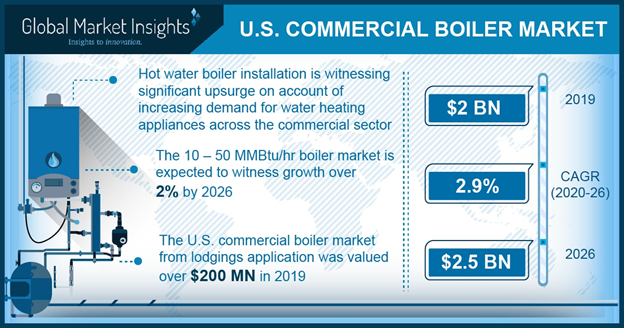U.S. commercial boiler market to accrue substantial proceeds from condensing system sales, regional industry to cross annual installations of 80,000 units by 2024
Publisher : Fractovia | Published Date : 2017-06-20Request Sample
The efforts put forth by the U.S. government to ensure energy optimization & lower energy consumption is certain to fuel U.S. commercial boiler market. Of late, regulatory organizations have become highly stringent as far as the carbon emissions is considered. On the grounds of environmental safety, products such as boilers are being required to be retrofitted with energy compliant technological advancements, thereby ensuring widespread opportunities for U.S. commercial boiler industry players. Incidentally, U.S. commercial boiler market size, driven by the expenditure toward the development of commercial centers and the growing demand for water and space heating across colder topographies, stood at USD 3 billion in 2017.
The U.S. government in tandem with numerous private bodies has been making substantial investments in infrastructural development, positively impacting U.S. commercial boiler market. This region has been experiencing a paradigm shift toward energy efficient construction. As per a statistical survey, the overall expenditure in the U.S. on the construction of green buildings surpassed an amount of USD 150 billion in 2015. This has essentially fueled U.S. commercial boiler market size from office applications, which in 2017, was pegged at USD 700 million.
East South Central Commercial Boiler Market size, By Capacity, 2016 & 2024 (USD Million)

One of the attributing factors toward the growth of U.S. commercial boiler industry is the expansion of the region’s tourism and hospitality sectors. As per statistics, the travel and tourism industry is one of the largest by revenue in the U.S., and in 2015, accounted for a stupendous USD 1.5 trillion of the country’s GDP. On these grounds, it is imperative to state that Florida, a nationally recognized tourist state, will contribute majorly toward the development of the U.S. commercial boiler industry, given that the region accounted for over USD 80 billion expenditure in the year 2014. Driven by the rising demand for commercial boilers in hotels and hospitals, U.S. commercial boiler market share from Florida is forecast to cross 1,500 unit installations by 2024.
Condensing systems are gaining popularity across the U.S., owing to the capability of the product to convert more than 90% of the heat into useful energy. The U.S. has deployed strict regulations to reduce the carbon footprints subject to the fact that increased pollution levels in the environment are being caused due to the incessant burning of fossil fuels. Condensing systems are also being launched across remote locations. Industry giants have been upgrading these systems and deploying them at various locations, pertaining to their excellent characteristics and subsequently high demand.
Speaking along similar lines, some of the noteworthy players in U.S. commercial boiler market are Superior Boiler Works, Columbia Boiler Co., Weil-McLain, Fulton, Cleaver Brooks, Bradford White Corporation, Hurst Boiler & Welding Co Inc., Rite Engineering and Manufacturing, Johnston Boiler, PB Heat, Vapor Power, Babcock and Wilcox, Burnham Commercial, ECR International, Victory Energy Operations, Groupe Simoneau Inc., P.M. Lattner Manufacturing, Parker Boiler, HTP - Water and Space Heating, Woodmaster, A.O. Smith, Clayton Industries, and RBI Boilers. Strictly governed by a regulatory frame of reference that enforces norms to optimize energy consumption, these firms are facing the challenge of bringing forth an array of products incorporated with highly innovative characteristics.
It is pivotal to mention that prior to the 2008 economic downturn, the U.S. commercial boiler industry experienced a backlash of sorts. However, post the resurgence of the economy, major firms partaking in U.S. commercial boiler market have been striving toward maintaining energy efficiency in product manufacturing. The efforts are apparently targeted at maintaining their business stance in the U.S. energy cosmos while simultaneously attempting to meet the changing regulatory landscape with regards to energy saving.
Consumers have lately been giving preference to boilers of capacity 0.3 to 2.5 MMBtu/hr, driven by its cost-effectiveness. Products of this capacity are extensively used for various applications such as retail, offices, public assemblies, and the educational sector. As per estimates, U.S. commercial boiler market from the 0.3 to 2.5 MMBtu/hr capacity segment will surpass a revenue generation of USD 500 million by 2024.
The U.S. government has been looking out for various alternatives to reduce pollution levels and generate energy. Subject to the availability of natural gas and the capacity of natural gas based boilers to emit less hazardous emissions, the number of installations of gas-fired boilers has observed a major incline lately. Statistics affirm that U.S. commercial boiler market share from gas-fired products will exceed USD 3 billion over 2018-2024, propelled by the products’ low emission rates, high efficiency, & robust infrastructure.
The technological advancements and the growing need for highly efficient products will create lucrative growth opportunities for the players of U.S. commercial boiler market over the years ahead. Aided by a powerful regulatory framework and numerous technological developments in product design and functionality, U.S. commercial boiler industry size will cross USD 3.5 billion by 2024.